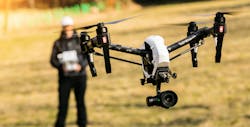The number of commercial drones in use in the U.S. is projected to triple, to 835,000 aircraft, between 2018 and 2023, according to the latest Federal Aviation Administration estimates. The number of remote pilots is on that same trajectory, and could hit nearly 350,000 by 2023.
Early this year, FAA proposed several rule changes that would liberalize where and when drones can fly. Those proposals also raise questions about privacy, security, and jurisdictional enforcement.
Remodelers are part of a “construction” classification that, through 2018, accounted for only 8% of drone “missions.” But some remodelers use drones for everything from roof inspections to creating marketing videos. For them, and others thinking about drones, here are some potential rule changes that bear watching.
1] Restrictions could be eased.
The FAA, which controls the national airspace, published its first Federal Aviation Regulations for drone use, known as Part 107, in June 2016. Those rules require all small, unmanned aerial vehicles used commercially to be registered, and their pilots to be tested and certified. Among the rules of compliance, a drone’s weight (including its payload) can’t exceed 55 pounds, and users must stay under a 400-foot altitude limit, fly during daylight hours and no closer than five miles to an airport, and keep a drone within its operator’s visual line of sight.
“You have to comply with airspace regulations in much the same way that airplanes do,” says Miriam McNabb, editor of DroneLife, an industry magazine and website.
FAA allows users to apply for waivers from many of its restrictions, and over the years has made the application process simpler, partly by outsourcing it. For example, FAA and the industry collaborate through the Low Altitude Authorization and Notification Capability (LAANC), an application and approval process for flying closer to airports. LAANC now covers more than 500 airports in the U.S. “It used to be a pain in the butt to get authorization to fly in controlled airspace; now you can get approval in five to 10 minutes,” says Alan Perlman, CEO and founder of UAV Coach, which offers drone pilot training.
He adds that the waiver process for night operations is also shorter (two to three weeks), with less paperwork. And since 2017, FAA’s Integration Pilot Program has worked with nine jurisdictions around the country to test real-world drone use for the purpose of guiding future regulations.
FAA, though, doesn’t dispense waivers willy nilly. Through 2018 it had approved 21.4% of requests for night operations, 1.2% for operating a drone beyond visual line of sight (BVLOS), and 0.6% for operating a drone over people.
In February, FAA published proposals that, if finalized, would end the general prohibition on flying drones over people, and lift prohibitions on night flights as long as the operator received training and the aircraft was lighted.
FAA won’t complete those changes until it settles, sometime later this year, on rules for remote identification, which would allow law enforcement, aviation, and other public officials to track drones by radar to find out who’s operating them.
“Remote ID is arguably the most important UAV-related policy issue currently under development,” Andrew Elefant, Director of Policy at Kittyhawk, the drone fleet management software provider, told the website Expouav.com. Perlman of UAVCoach suggests that Remote ID could go a long way toward relaxing BVLOS restrictions, although he also thinks some kind of drone air-traffic control would need to be established.
2] The states could demand more say over drone operations.
FAA’s rulings on drone restrictions and Remote ID are not likely to be the final words on these topics.
So far, FAA has declined to address privacy issues related to drone use, so what constitutes private airspace remains unclear. Further complicating this issue has been the interest in using drones to deliver products by companies like Alphabet's Wing, which in April received approval to start delivering goods by drones to rural Virginia; and Amazon, whose future delivery system Prime Air has been issued a special airworthiness certificate to operate drones for research, development, and crew training in authorized flight areas. Among Amazon’s plans is to offer drone surveillance as a service.
There is debate about whether state or municipal drone laws can supersede FAA rules. But that hasn’t stopped them from trying. “Some states have created their own laws to give state and local authorities the ability to take action if they believe someone is operating a drones unsafely or illegally,” says Adam Lisberg, a spokesperson for DJI, the drone manufacturer that accounts for 70% of the drone market.
The National Conference of State Legislatures says that at least 41 states have enacted drone-related regulations or rules, 27 have enacted privacy-related measures, 21 have criminalized certain uses of drones, 19 require warrants before drones can be used for surveillance, and 10 prohibit drone flights over critical infrastructure. (UAVCoach also maintains a database of state drone laws on their website.)
The Uniform Law Commission recently proposed revisions to its model Tort Law Relating to Drones Act. Previously, ULC had called for a ban on drones flying within 200 feet above private property. Its revision eliminates that arbitrary line in the sky and gives courts more guidance about what factors they should consider, like how long the aircraft hovered over the property, or an operator’s intent. The revision still prevents drones from touching private property without the owner’s permission, but otherwise the landowner would have to prove how a hovering drone interfered with the enjoyment of the land use.
Perlman doesn’t think privacy and state enforcement issues will be resolved anytime soon. “There are angry neighbors out there who will tap you on the shoulder," he says. "So it’s important to know what your rights are.”
About the Author

John Caulfield
Contributing editor John Caulfield writes about issues affecting the new-construction, exterior-replacement, and remodeling industries. He is a senior editor with Professional Remodeler's sister publication Building Design + Construction.
